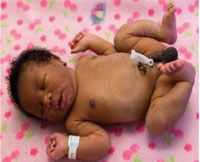7.1.1 Breathing in a healthy newborn
Normally, a healthy baby starts to breath spontaneously immediately after delivery (Figure 7.1). If the breathing started spontaneously and is sustained by the baby without assistance, it indicates that:
- The fetus was not asphyxiated while in the uterus
- The respiratory system is functioning well
- The cardiovascular system (heart and blood vessels) is functioning well
- There is coordination by the brain of the movements required for sustained rhythmical breathing (brain is functioning well).

How do you check fetal wellbeing during labour and delivery?
A healthy fetus has a heart rate between 120–160 beats/minute. When the fetal membranes rupture, the amniotic fluid that leaks from the mother’s vagina is clear, not heavily blood-stained or coloured greenish-black by meconium — the baby’s first stool.
If you checked the fetal heart rate at regular intervals all through the mother’s labour, and recorded the result on the partograph (as you learned in Study Session 4), you should have referred any mother whose unborn baby showed signs of fetal distress. Therefore, it should be relatively uncommon for you to deliver an asphyxiated baby. However, complications in childbirth can develop unpredictably, or you may be called to a woman who is already far advanced in the second stage of labour when you reach her. Therefore, you need to know how to provide neonatal resuscitation in case you deliver an asphyxiated baby.
7.1 Newborn respiration and resuscitation
